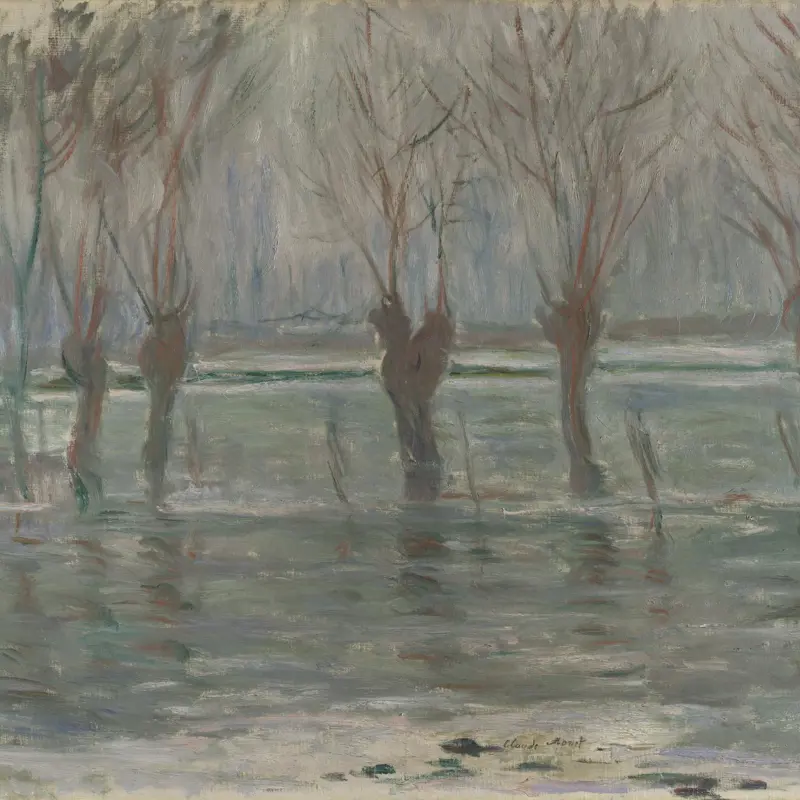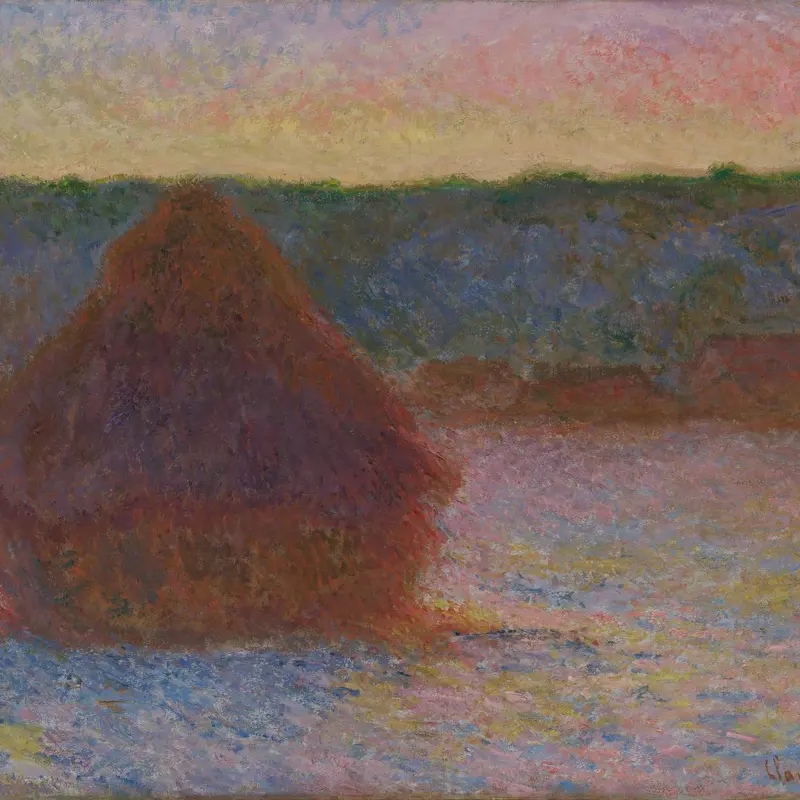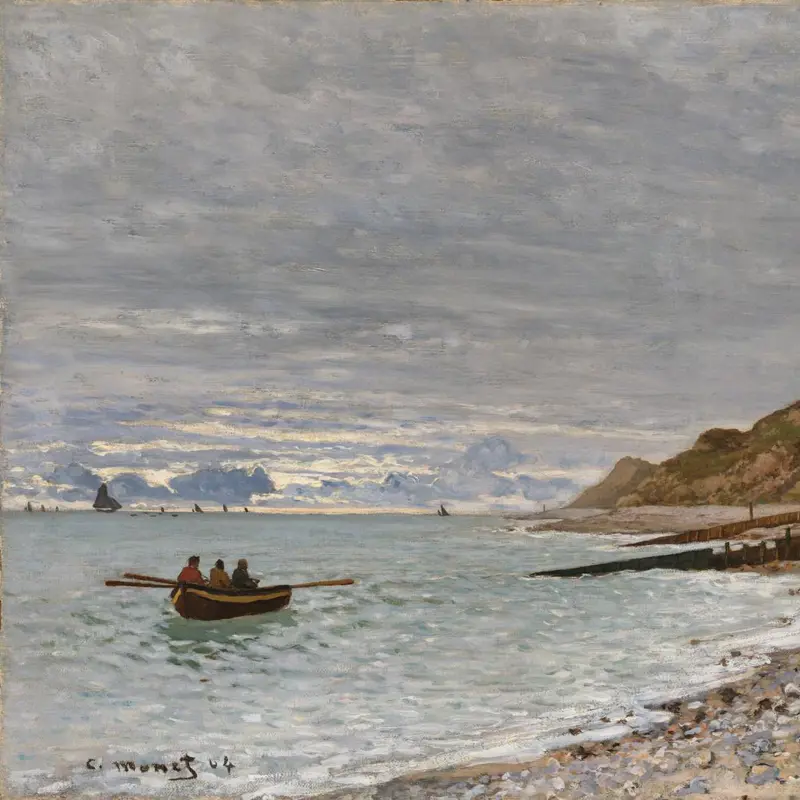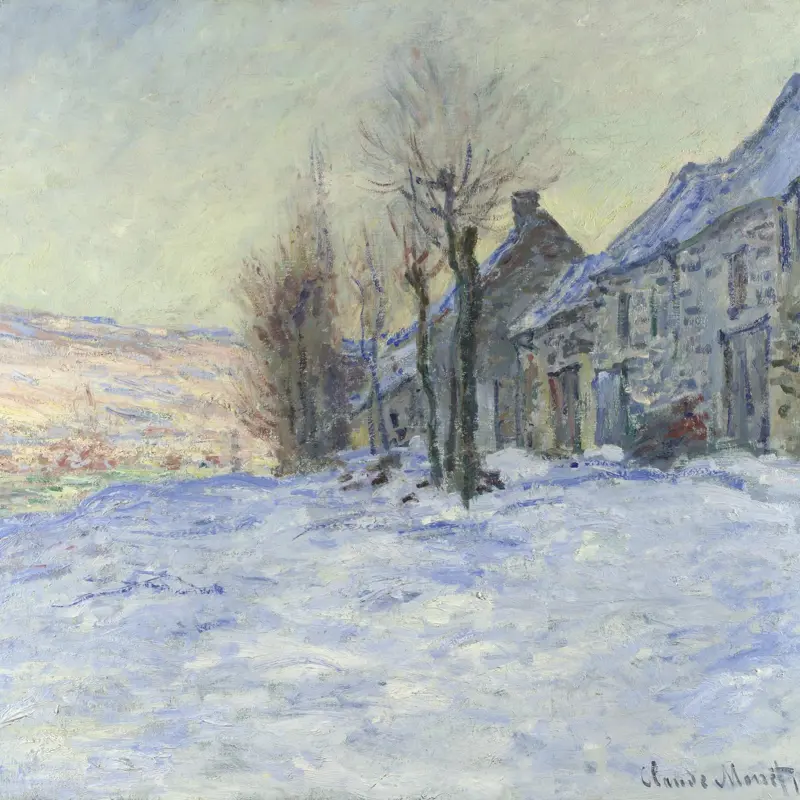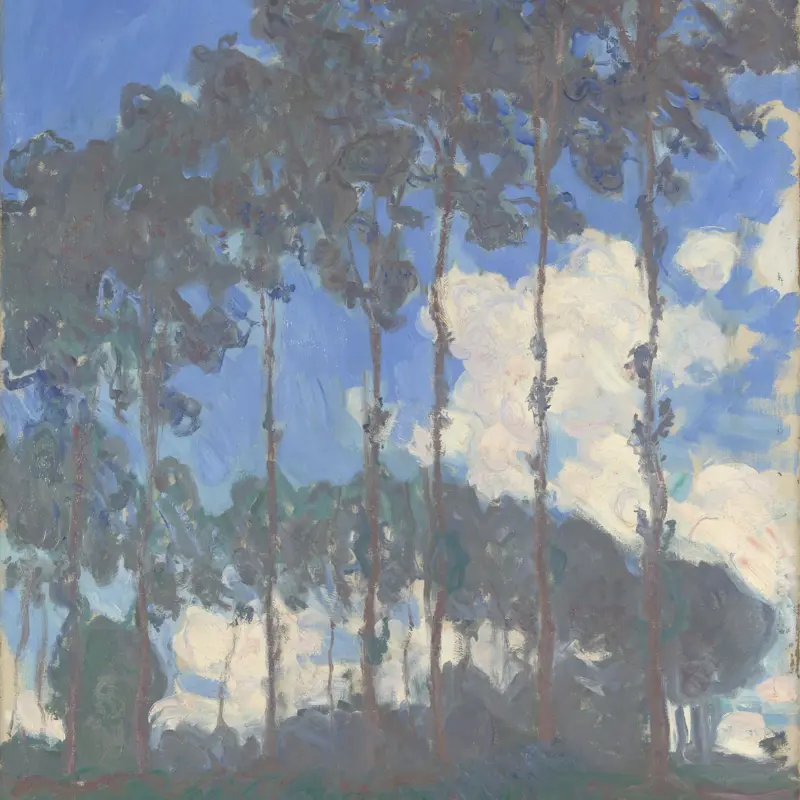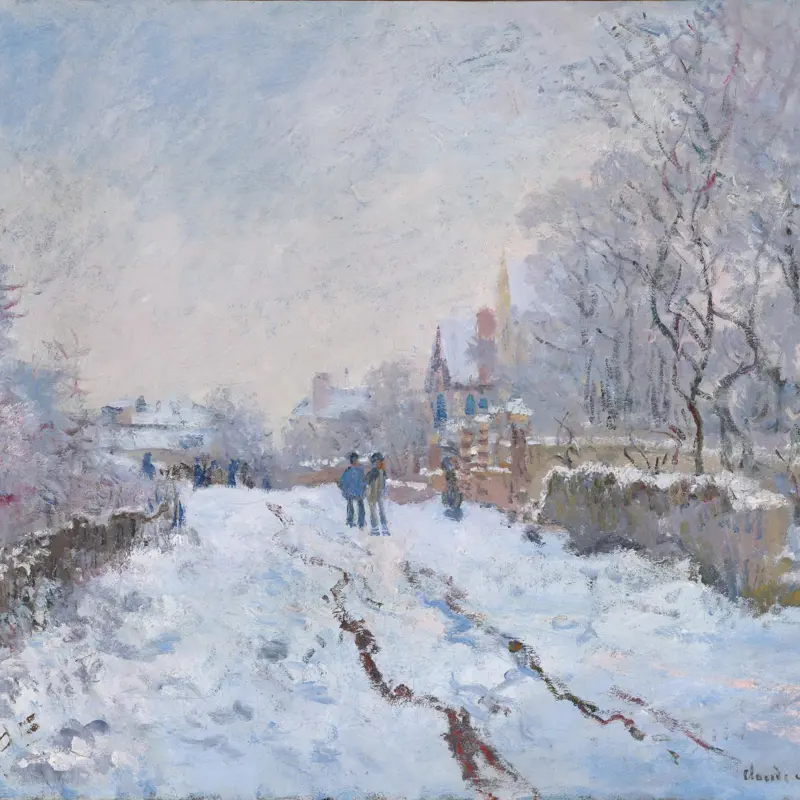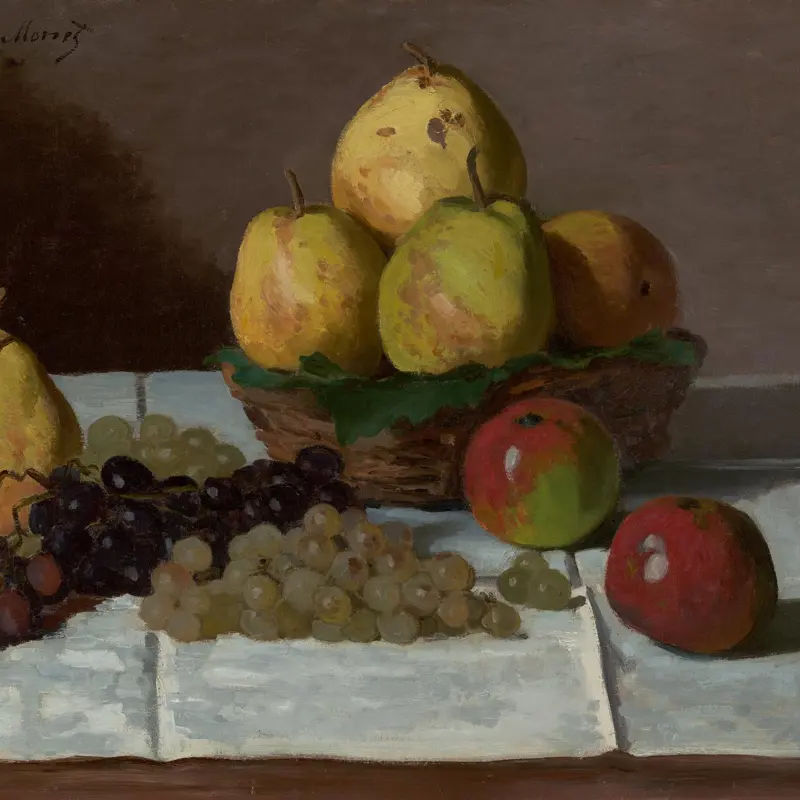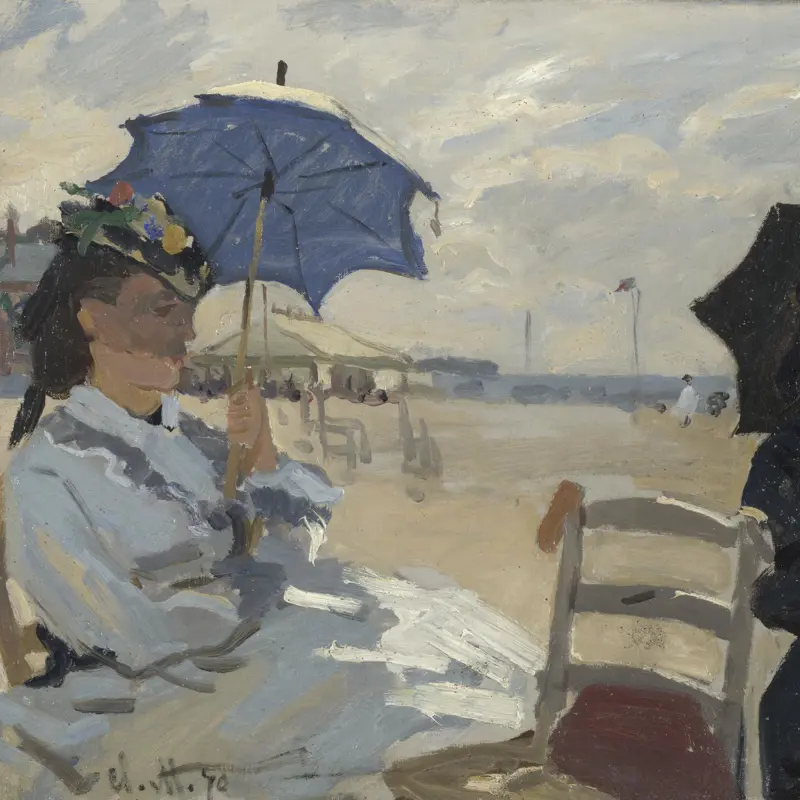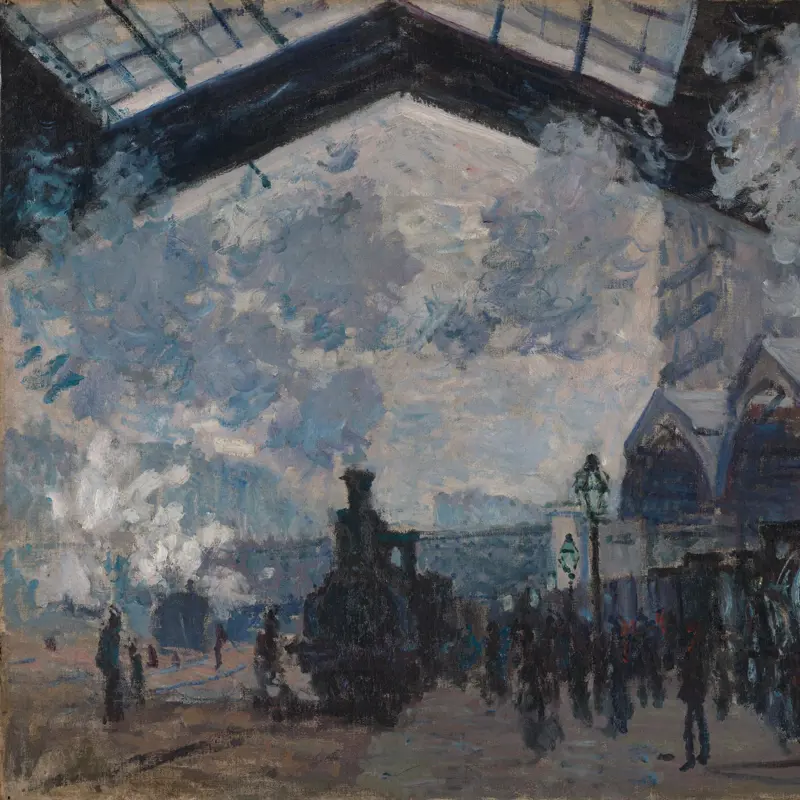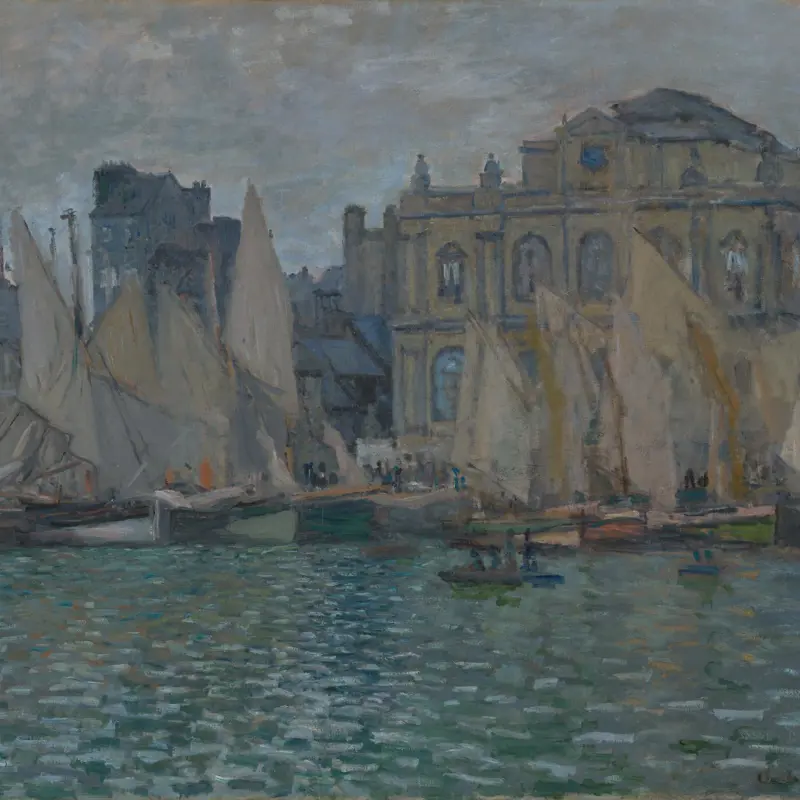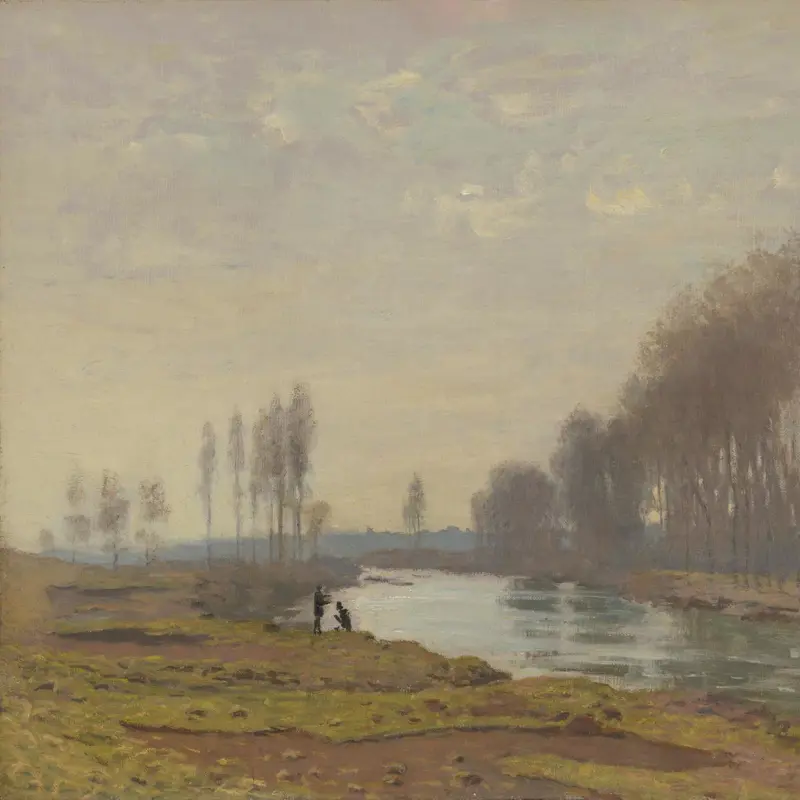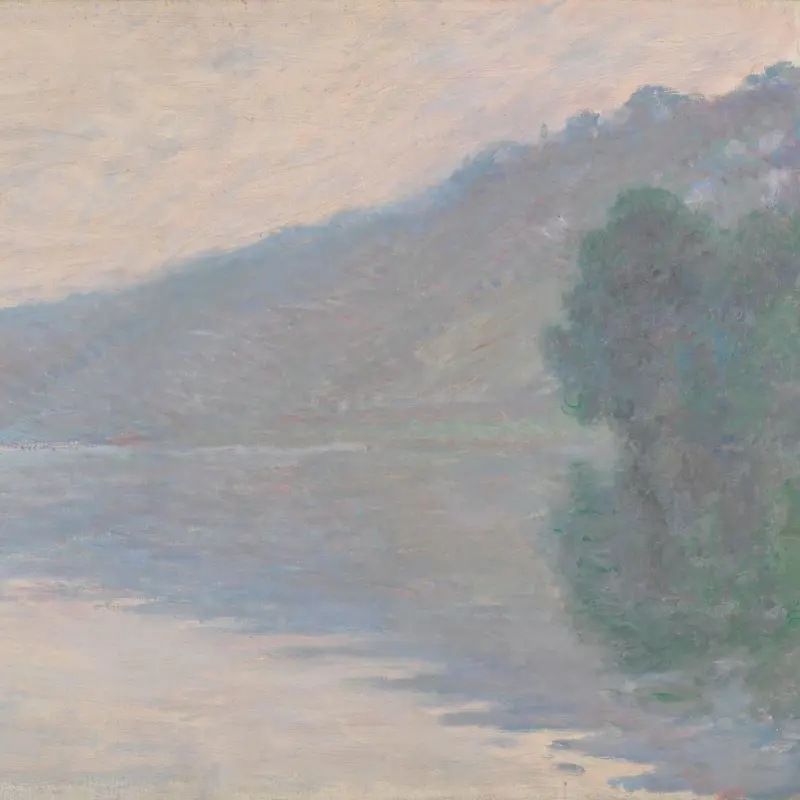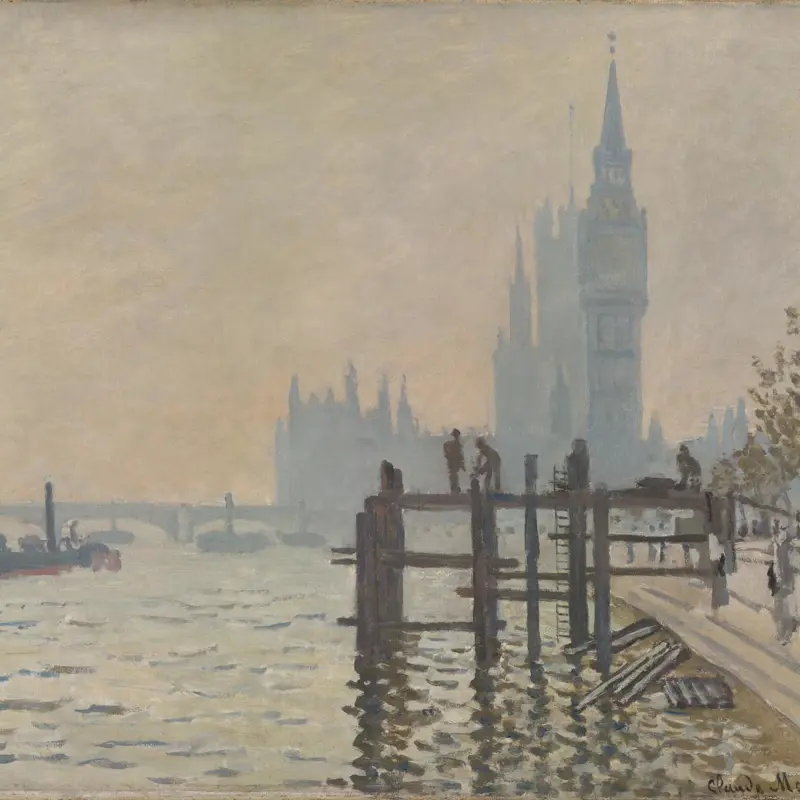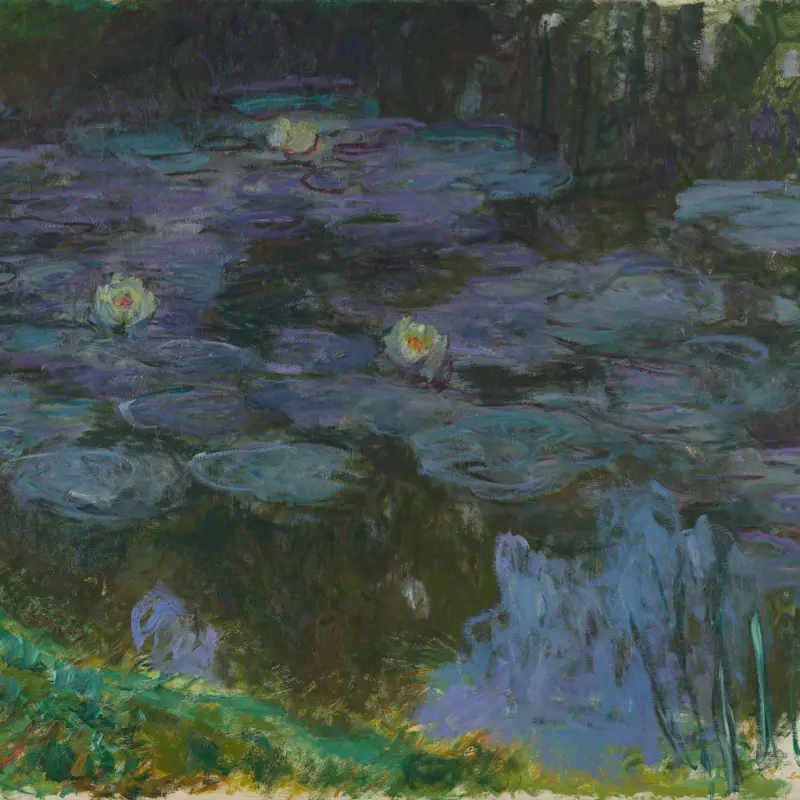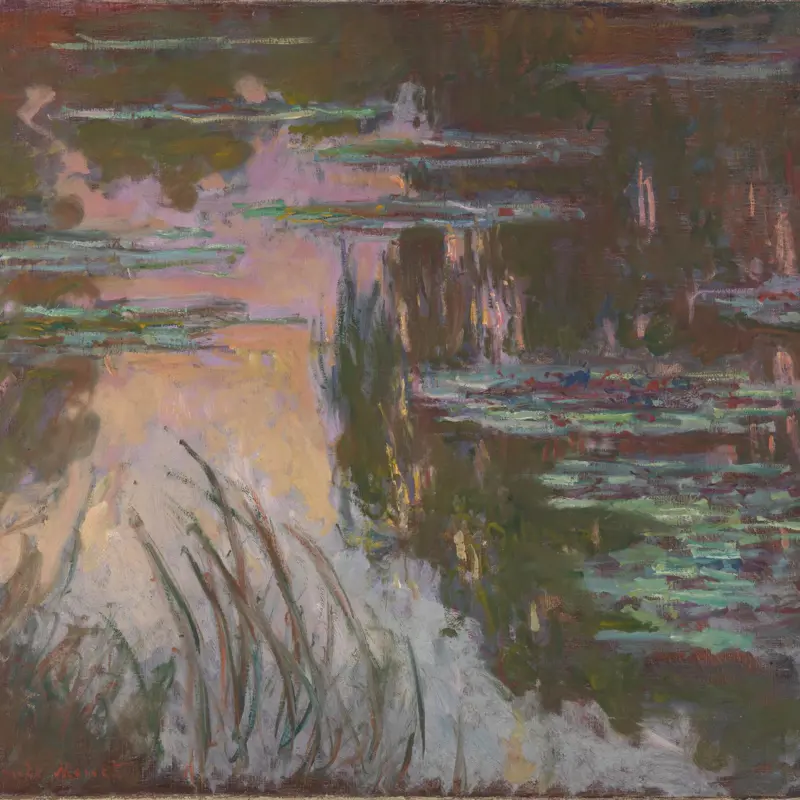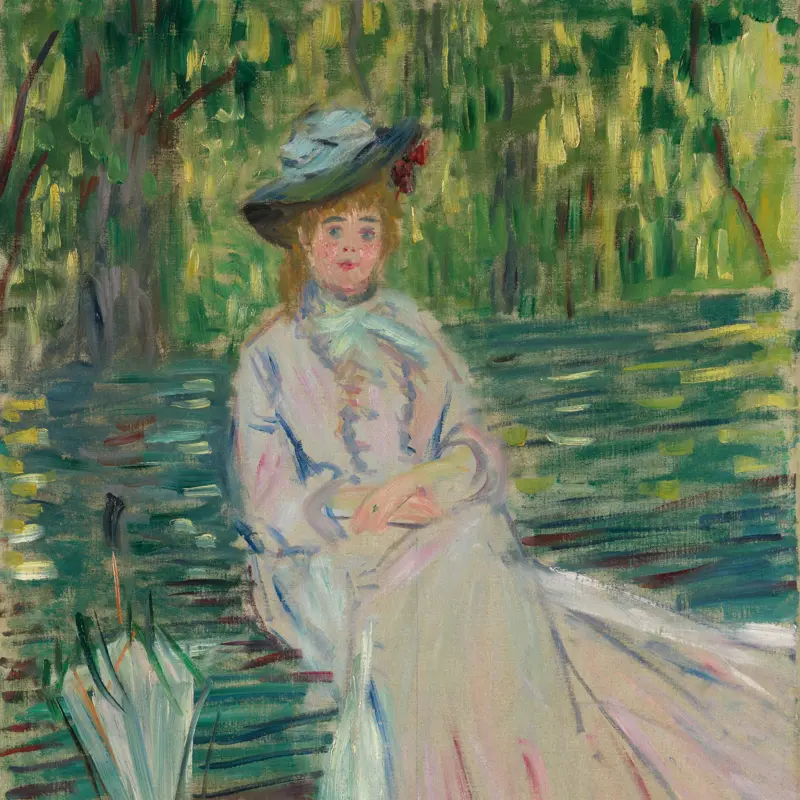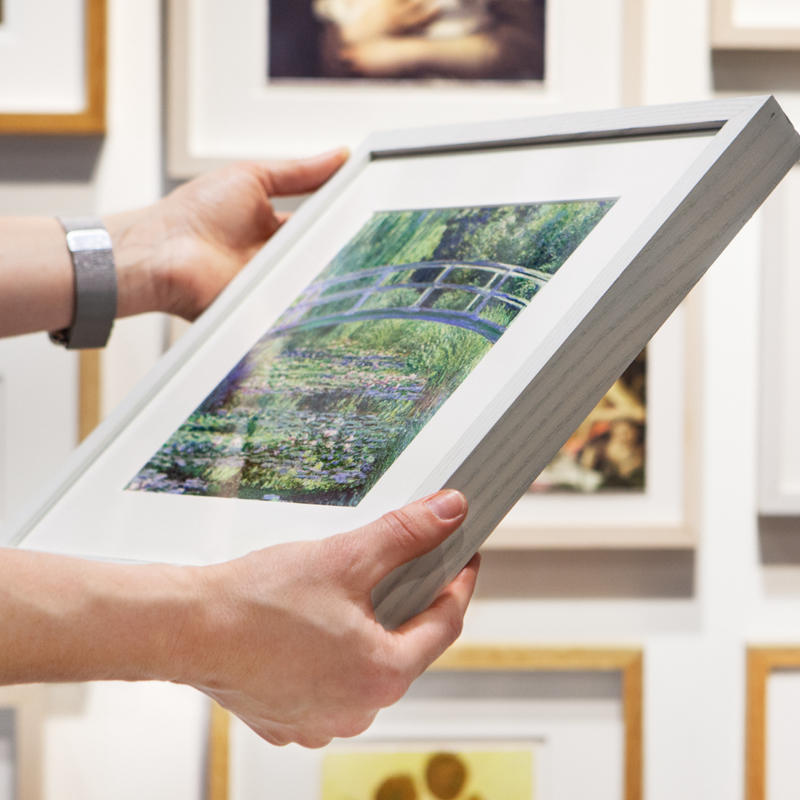Claude Monet, 'The Water-Lily Pond', 1899
About the work
Overview
In 1893 Monet bought a plot of land next to his house in Giverny. He had already planted a colourful flower garden, but now he wanted to create a water garden ‘both for the pleasure of the eye and for the purpose of having subjects to paint'. He enlarged the existing pond, filling it with exotic new hybrid water lilies, and built a humpback bridge at one end, inspired by examples seen in Japanese prints. The water garden became the main obsession of Monet’s later career, and the subject of some 250 paintings.
Here, the bridge spans the width of the canvas but is cut off at the edges so that it seems to float unanchored above the water, its shape reflected in a dark arc at the bottom of the picture. The perspective seems to shift; it is as though we are looking up at the bridge but down on the water lilies which float towards the distance. The vertical reflections of the trees provide a counterpoint to the horizontal clumps of the lily pads.
Audio description
Listen to an audio description of Claude Monet's 'The Water-Lily Pond'
Transcript
This is a description of The Water-Lily Pond by Claude Monet. It was painted in 1899 and is one in a series of paintings that Monet made of his garden in Giverny. The relatively small work is just under a metre square and executed in colourful oil paint. It depicts a Japanese-style bridge that Monet had built over his lily pond. The arched footbridge is centrally placed and spans the width of the painting. Above the bridge, the upper part of the painting is filled with distant trees, including weeping willows, that surround the pond. The foreground is filled with water lilies blooming between up thrusting reedbeds. This vibrant and lush painting is saturated with dense plant life. It is composed in a bright colour palette of verdant greens and yellows with lavender blue and purple hues - punctuated with spots of red and pink. The footbridge was constructed by Monet in his purpose-built water garden and was inspired by Japanese woodcuts from his collection. It’s delicate and graceful, gently curving bridge is executed in vibrant blue and green brushstrokes and is the focal point of the painting. The bridge spans the width of the canvas but is cut off at the edges so that it seems to float unanchored above the water, its shape reflected in a dark arc at the bottom of the picture. Monet and his fellow Impressionists had a knack for applying colour in unexpected ways but making them look and feel entirely natural. Here, Monet gives the impression of a wooden bridge caught in the filtered
summer sunlight reflecting from the pond’s surface. However, the bridge’s original colour is no longer part of the visual equation. Monet has painted the drooping soft green willow trees with long vertical brushstrokes, and where the water’s surface appears below, he repeats this technique to show their watery reflection. The reflections in the water are a testament to Monet's keen observation of light and its ever-changing qualities. Below the bridge, broken brushstrokes and daubs of colour illustrate the crowded surface of the water: the dusky pinks and cornflower blues of the blossoming lilies breaking through the dominant greens. The water lilies, in various stages of bloom, float delicately upon the pond's surface. The picture immerses the viewer in the feeling of a summer’s afternoon, sitting lazily by the shaded water’s edge. Even in the midst of winter the painting can conjure the warmth of the sun, the rippling surface of the water, the smell of plants and flowers, and the gentle wind stirring the trees. Monet was a keen gardener. He constructed this bridge at the neck of the pond in 1895 and started painting it that same year. The art critic Maurice Guillemot visited the garden in 1898, poetically describing “the calm and the silence of the dead water reflecting the extensive efflorescence; the colours are imprecise, deliciously nuanced, with the delicacy of dream.” One can understand why Monet wanted to paint
his garden, as he did in about 250 canvases. In each painting he plays with subtle differences in light, colour, time of day, weather, and point of view. Sometimes, he placed his easel directly on the bridge, allowing a close view of the waterlilies blossoming below. At other times he painted from a boat in the pond, which might be the case here. In relation to his pond, Monet explained that the water flowers are far from being the whole scene; really, they are just the accompaniment. The essence of the motif is the mirror of water whose appearance alters at every moment, thanks to the patches of sky that reflected in it and which gives it light and movement.’ In this painting, the density of the reflected vegetation and the bed of waterlilies barely reveals any patches of sky. Increasingly, Monet’s paintings of the pond would gain almost abstract qualities, but this version of 1899 still feels anchored in perceivable reality.
Key facts
Details
- Full title
- The Water-Lily Pond
- Artist
- Claude Monet
- Artist dates
- 1840 - 1926
- Date made
- 1899
- Medium and support
- Oil on canvas
- Dimensions
- 88.3 × 93.1 cm
- Inscription summary
- Signed; Dated
- Acquisition credit
- Bought, 1927
- Inventory number
- NG4240
- Location
- Room 46
- Collection
- Main Collection
- Frame
- 17th-century Italian Frame
Provenance
Additional information
Text extracted from the ‘Provenance’ section of the catalogue entry in Martin Davies, with additions and some revisions by Cecil Gould, ‘National Gallery Catalogues: French School: Early 19th Century, Impressionists, Post-Impressionists, etc.’, London 1970 and supplemented by Isobel Muir; for further information, see the full catalogue entry.
Exhibition history
-
2008The Simon Sainsbury Bequest to The National GalleryThe National Gallery (London)22 October 2008 - 1 February 2009
-
2010Claude Monet: 1840-1926Galeries Nationales du Grand Palais22 September 2010 - 24 January 2011
-
2014Monet: The Water Garden at GivernyThe National Gallery (London)16 September 2014 - 31 December 2015
-
2016Monet. Beyond ImpressionismOrdrupgaard24 August 2016 - 4 December 2016
-
2018The Credit Suisse Exhibition: Monet & ArchitectureThe National Gallery (London)9 April 2018 - 29 July 2018
-
2019Monet. The Garden PaintingsKunstmuseum Den Haag12 October 2019 - 2 February 2020
-
2020Masterpieces from the National Gallery, LondonThe National Museum of Western Art18 June 2020 - 18 October 2020The National Museum of Art3 November 2020 - 31 January 2021
-
2021Botticelli to Van Gogh: Masterpieces from the National Gallery, LondonNational Gallery of Australia5 March 2021 - 14 June 2021
-
2021Impressionist Decorations: The birth of modern décorMusée de l'Orangerie1 March 2022 - 11 July 2022
-
2024National TreasuresYork Art Gallery10 May 2024 - 8 September 2024
Bibliography
-
1900A. Alexandre, 'La vie artistique: Exposition Claude Monet', Le Figaro, IV, 1900
-
1900A. de Calonne, 'Beaux-arts: M. Claude Monet', Le Soleil, 1900
-
1900G. Denoinville, 'Tribune artistique: Petits salons', Le Voltaire, 1900
-
1900J. Leclercq, '"Le Bassin de Nymphéas" de Claude Monet', La Chronique des arts, 1900, pp. 363-4
-
1900C. Saunier, 'Petite gazette d'art: Claude Monet', Revue blanche, XXII/181, 1900
-
1904M. Kahn, 'Le jardin de Claude Monet', Le Temps, 1904
-
1921A. Alexandre, Claude Monet, Paris 1921
-
1922G. Geffroy, Claude Monet, sa vie, son temps, son oeuvre, Paris 1922
-
1922G. Geffroy, Monet, Paris 1922
-
1934S. Gwynn, Claude Monet and His Garden, London 1934
-
1939L. Venturi, Les archives de l'impressionnisme, Paris 1939
-
1948O. Reuterswärd, Monet, Stockholm 1948
-
1954D. Cooper, The Courtauld Collection: A Catalogue and Introduction, London 1954
-
1959R. Alley, Tate Gallery Catalogues: The Foreign Paintings, Drawings and Sculpture, London 1959
-
1960J.P. Hoschedé, Claude Monet, ce mal connu, Geneva 1960
-
1970Davies, Martin, and Cecil Gould, National Gallery Catalogues: French School: Early 19th Century, Impressionists, Post-Impressionists etc., London 1970
-
1972D. Rouart, J.-D. Rey and R. Maillard, Monet nymphéas ou les miroirs du temps, Paris 1972
-
1973R. Gordon, 'The Lily-Pond at Giverny: The Changing Inspiration of Monet', The Connoisseur, 1973, pp. 154-65
-
1974D. Wildenstein, Claude Monet: Biographie et catalogue raisonné, 4 vols, Lausanne 1974
-
1975C. Joyes et al., Monet at Giverny, London 1975
-
1978D. Wildenstein, 'Monet's Giverny', in C.S. Moffett et al., Monet's Years at Giverny: Beyond Impressionism, New York 1978, pp. 14-40
-
1978K. Varnedoe, 'In Monet's Gardens', New York Times Magazine, 1978, pp. 30-41
-
1979R. Gordon and F. Stuckey, 'Blossoms and Blunders. Monet and the State', Art in America, LXVII/1, 1979, pp. 102-17
-
1981J. House, Monet, Oxford 1981
-
1981G. Seiberling, Monet's Series, New York 1981
-
1983R. Gordon and A. Forge, Monet, New York 1983
-
1983J. House, Claude Monet in the Time of Giverny (exh. cat. Centre Culturel du Marais, 1983), Paris 1983
-
1986D. Abse and J. Abse, Voices in the Gallery: Poems and Pictures, London 1986
-
1986J. House, Monet: Nature into Art, New Haven 1986
-
1990P.H. Tucker, Monet in the '90s: The Series Paintings (exh. cat. Museum of Fine Arts, Boston, 7 February - 29 April 1990; Art Institute of Chicago, 19 May - 12 August 1990; Royal Academy of Arts, 7 September - 9 December 1990), Boston 1990
-
1992V. Spate, The Colour of Time: Claude Monet, London 1992
-
1994K. Sagner-Düchting, Monet in Giverny, Munich 1994
-
1995P.H. Tucker, Claude Monet: Life and Art, New Haven 1995
-
1996D. Wildenstein, Claude Monet. Catalogue raisonné, Cologne 1996
-
1996S. Koja, Claude Monet (exh. cat. Österreichische Galerie Belvedere, 13 March - 16 June 1996), Munich 1996
-
2001
C. Baker and T. Henry, The National Gallery: Complete Illustrated Catalogue, London 2001
-
2004C. Becker, Monet's Garden, Zurich 2004
About this record
If you know more about this work or have spotted an error, please contact us. Please note that exhibition histories are listed from 2009 onwards. Bibliographies may not be complete; more comprehensive information is available in the National Gallery Library.


